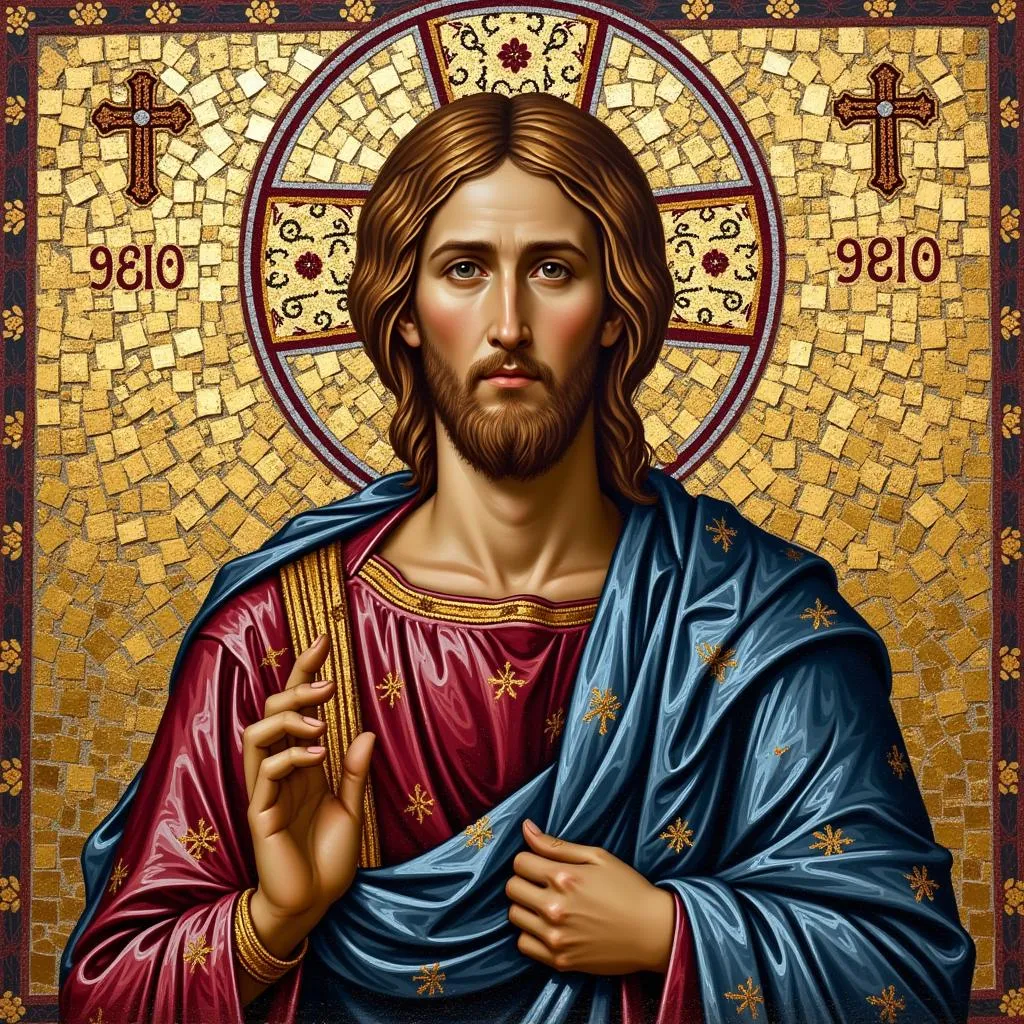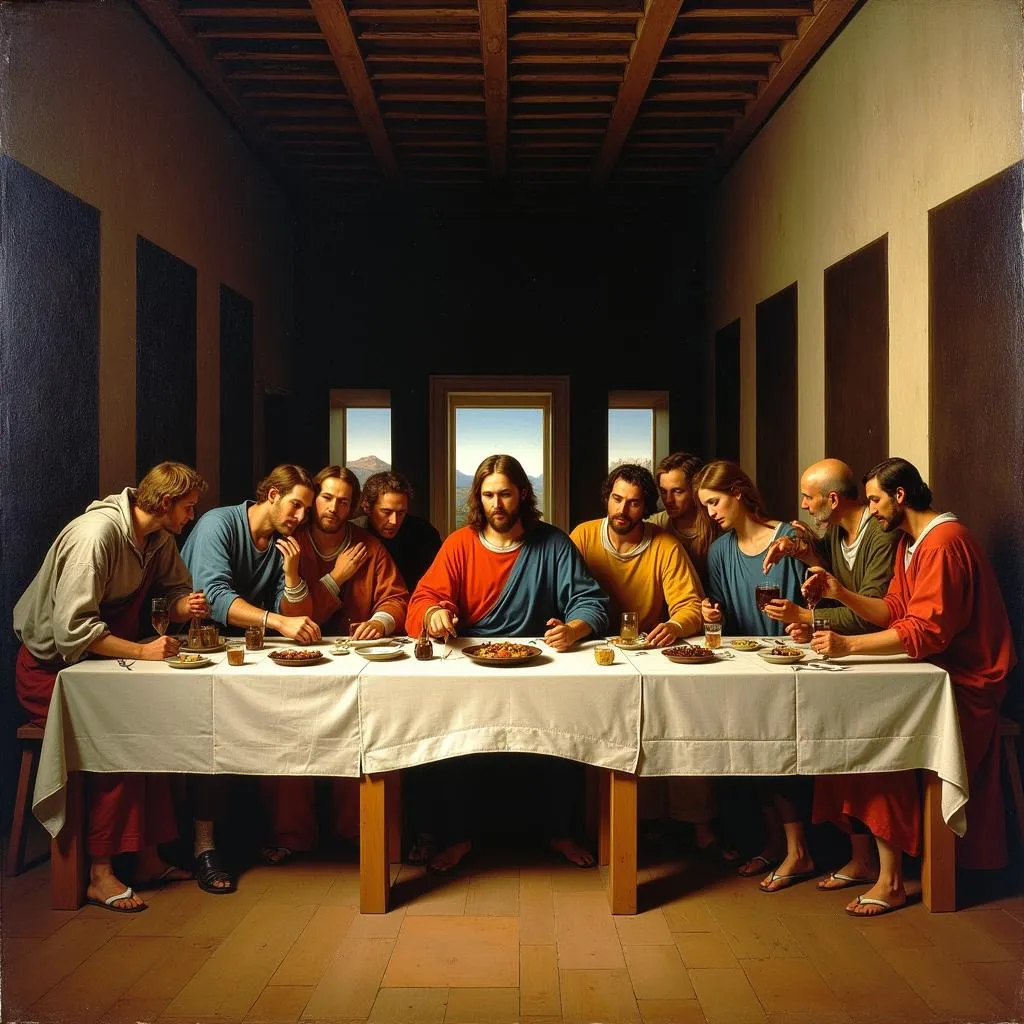The Enduring Art of Christ: Exploring Its Impact and Significance
The Art Of Christ, encompassing centuries of artistic representations of Jesus Christ, continues to captivate and inspire viewers worldwide. From iconic Byzantine mosaics to Renaissance masterpieces and contemporary interpretations, depictions of Christ offer a unique window into evolving artistic styles, theological perspectives, and cultural values. This article delves into the enduring legacy of the art of Christ, exploring its historical context, artistic evolution, and enduring significance in shaping our understanding of faith, humanity, and the divine.
 Byzantine art depicting Jesus Christ
Byzantine art depicting Jesus Christ
The Evolution of Christ’s Image: From Early Symbols to Realistic Portrayals
In the early centuries of Christianity, artists employed symbolic representations of Christ, reflecting the nascent religion’s cautious approach to depicting the divine. The fish (ichthys), the Good Shepherd, and the Chi-Rho monogram served as visual shorthand for Christ’s teachings and identity. However, as Christianity gained prominence, so did the desire for more direct portrayals. Byzantine art, flourishing from the 4th century onwards, established a canon of imagery that profoundly influenced subsequent artistic traditions. Byzantine mosaics and icons presented Christ as the Pantocrator (ruler of all), often with a stern countenance and ethereal aura, emphasizing his divine authority.
The Renaissance witnessed a shift towards naturalism and humanism in art. Artists like Leonardo da Vinci and Michelangelo sought to depict Christ with greater realism, emphasizing his humanity alongside his divinity. This humanistic approach resonated deeply with viewers, fostering a more intimate connection with the figure of Christ.
 Leonardo da Vinci's The Last Supper
Leonardo da Vinci's The Last Supper
Beyond the Canvas: Thematic Explorations in the Art of Christ
The art of Christ extends beyond mere portraiture, encompassing a rich tapestry of themes drawn from his life, teachings, and significance. From scenes of his birth, miracles, and crucifixion to allegorical representations of his sacrifice and resurrection, artists have grappled with profound theological concepts through their work.
- The Nativity: Depictions of the Nativity often emphasize the humility of Christ’s birth, contrasting it with his divine origin. The use of light, symbolism, and the presence of both earthly and heavenly figures serve to highlight the momentous nature of the event.
- Miracles: Christ’s miracles, such as the healing of the sick and the feeding of the multitude, offered artists opportunities to showcase his compassion and power. These scenes often emphasize the emotional impact of the miracles on those present, further humanizing the figure of Christ.
- The Crucifixion: The crucifixion, a central event in Christian theology, has been a recurring subject in art throughout history. Artists have depicted the agony and sacrifice of Christ with varying degrees of realism and emotional intensity, inviting viewers to contemplate the weight of his sacrifice.
- The Resurrection: Representations of the resurrection often convey a sense of triumph over death and the promise of eternal life. Artists have employed symbolism, light, and dynamic compositions to express the transformative power of this event.
The Enduring Significance of the Art of Christ
The art of Christ continues to resonate with viewers across cultures and time periods, offering a timeless message of hope, redemption, and the enduring power of faith. These depictions invite us to contemplate our own relationship with spirituality, morality, and the human condition.
Finding Meaning in Artistic Interpretations
Whether through the awe-inspiring grandeur of Byzantine mosaics, the humanistic realism of Renaissance masterpieces, or the thought-provoking interpretations of contemporary artists, the art of Christ provides a rich tapestry of perspectives on faith, humanity, and the divine. By engaging with these diverse artistic expressions, viewers can deepen their understanding of Christ’s message and its enduring relevance in the 21st century.
Frequently Asked Questions about the Art of Christ
-
What is the earliest known depiction of Jesus Christ? While there are no confirmed portraits of Christ from his lifetime, some of the earliest known depictions, dating back to the 3rd century, are found in the catacombs of Rome.
-
How has the depiction of Christ changed over time? The portrayal of Christ has evolved significantly, reflecting changing artistic styles, theological interpretations, and cultural contexts. From early symbolic representations to realistic portraits and contemporary interpretations, artists have continuously reimagined Christ’s image.
-
What is the significance of the halo in Christian art? The halo, a circle of light surrounding the head of a holy figure, symbolizes divinity, holiness, and spiritual enlightenment.
-
Why is the art of Christ still relevant today? The art of Christ transcends cultural and historical boundaries, offering timeless messages of hope, love, and redemption that continue to resonate with viewers in the 21st century.
-
Where can I see famous examples of the art of Christ? Masterpieces of Christian art can be found in museums and churches worldwide. Some renowned collections include the Vatican Museums, the Louvre Museum, and the Metropolitan Museum of Art.
Need Help? Contact Us
If you have any questions or require assistance, please feel free to contact us.
Phone Number: 02462573573
Email: danteum@gmail.com
Address: Savico Megamall, 7-9 Đ. Nguyễn Văn Linh, Gia Thụy, Long Biên, Hà Nội 10000, Việt Nam.
Our dedicated customer support team is available 24/7 to assist you.





